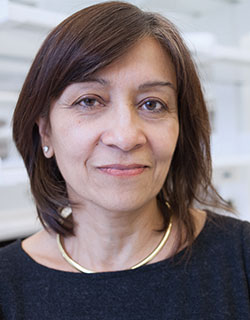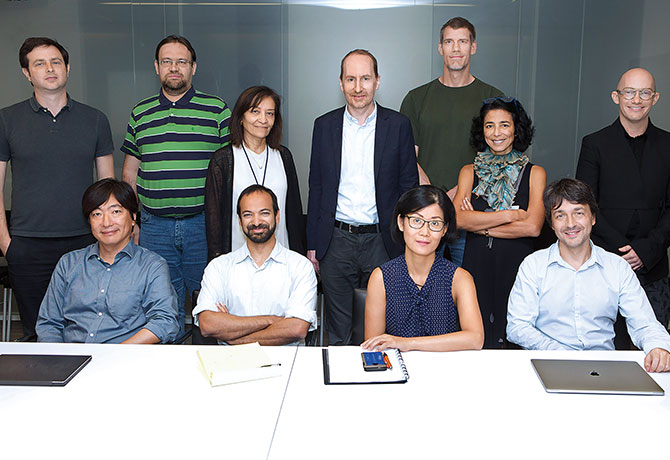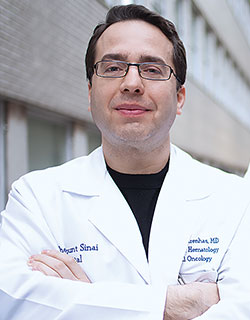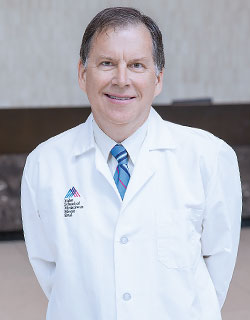
The Tisch Cancer Institute
At The Tisch Cancer Institute, a National Cancer Institute-designated center, our multidisciplinary approach to cancer treatments and clinical breakthroughs may one day put an end to cancer.
The Tisch Cancer Institute
Innovation and transformation energize our programs and reflect The Tisch Cancer Institute’s world-class research. We are a National Cancer Institute-designated Cancer Center and have joined an elite group of U.S. institutions committed to the research and treatment of cancer.
This specialty report highlights:
- A Q&A with Nina Bhardwaj, MD, PhD, on cancer immunotherapy
- A unique program that takes mammography screening to New York City’s five boroughs
- A new grant that supports clinical trials in immunotherapy
- Mount Sinai setting the standards for low-dose lung cancer screening
- Images of cancer activity
- A new clinical home for adult leukemia patients
A New Frontier in Cancer Immunotherapy: Q&A with Nina Bhardwaj, MD, PhD

Nina Bhardwaj, MD, PhD, the Ward-Coleman Chair in Cancer Research and Director of Immunotherapy, has developed toll-like receptor (TLR) agonist– and dendritic cell–based vaccines for cancer and infections that are currently being tested in clinical trials. Recently, the Parker Institute for Cancer Immunotherapy invited her to participate in collaborative research with scientists from nine top medical centers around the country. Dr. Bhardwaj, who runs the Icahn School of Medicine at Mount Sinai’s Vaccine and Cell Therapy Laboratory, weighs in on the latest advances in combination therapies and the promising road ahead.
What are the most promising cancer immunotherapies, thus far?
Dr. Bhardwaj: The major ones are the checkpoint inhibitors. They have really changed the profile of how we treat cancer and improved the patient response rate up to 20 percent and possibly to more than 50 percent in some cases. The next step will be combining checkpoint inhibitors with other checkpoint inhibitors, drugs, agonists, immune modulators, or vaccines. In addition, adoptive T-cell therapies are changing the landscape of treatment in certain hematological malignancies, with promise in solid tumors. We are also injecting immune modulators directly into tumors and combining that with checkpoint inhibitors, as well as testing some molecules that mobilize and activate dendritic cells.
Do certain cancers seem to respond best to immunotherapies?
Dr. Bhardwaj: Checkpoint inhibitor therapy has been approved in more than a dozen cancers. We know some cancers have high mutational burdens, and cancers that have a deficiency in DNA repair are especially responsive to immunotherapy based on using checkpoint inhibitor therapy. In some cases where you have more mutations, a greater breadth of new antigens can be targeted by the immune system. With checkpoint inhibitors, T-cells that might have been shut off are now being reinvigorated so that you have the capacity to attack the tumors.

How do we build upon our current successes?
Dr. Bhardwaj: We have to determine which combinations of platforms are going to work best for our patients and the cancers they have. Understanding the tumor
microenvironment, which includes the cellular composition and the genomic and transcriptomic features, and tailoring it to the treatment of individual patients is part of that. So is treating tumors early rather than much later. For example, we are beginning to appreciate that “neoadjuvant” treatment may be very effective in reducing tumor burden, and treatment in the adjuvant setting may prolong survival. Also, as we learn more about new antigens and how to profile them, we will continue to find unique ways to incorporate them into effective therapies against cancer.
What is your role with the Parker Institute for Cancer Immunotherapy?
Dr. Bhardwaj: I am an extramural member researcher at the Parker Institute, working very closely and collaboratively with other member researchers. One of my roles is evaluating how to efficiently develop personalized cancer vaccines and to identify the most effective vaccine adjuvant platform in order to incorporate it into a cancer vaccine program. I am also part of the Tumor Epitope Selection Alliance, in which the Parker Institute has brought together several teams to better understand how to predict neoantigens for vaccination.
How important is collaboration in moving cancer immunotherapy forward?
Dr. Bhardwaj: Collaborations bring together institutions, industry partners, and investigators who would otherwise be working separately. They also enhance the availability of technology to investigators, and the sharing of data, specimens, and information that will help to galvanize discovery and testing of new therapies. This partnership has been essential for bringing immunotherapy into the clinic and is proving particularly important in better understanding the tumor microenvironment; for example, what constituents are in a tumor, what do different tumors look like, and what cells and markers in the tumor are good or bad? It will also be key in identifying biomarkers that predict response to immune interventions.
What makes Mount Sinai’s Vaccine and Cell Therapy Laboratory unique?
Dr. Bhardwaj: This lab prepares all of our cell-based protein and peptide-based vaccines that conform to Good Manufacturing Practices. Anything vaccine-related that comes under our umbrella is done at this site. What’s unique about our work here is our platform to select neoantigens and develop a patient-unique cancer vaccine. This is the first trial of its kind at our institution, and we’re very excited about that. We can also do stem cell production and manipulation at this site. In the future, we hope to be able to produce and manipulate dendritic cell subsets from stem cells for vaccine trials.
Can you provide an update on the trial you are conducting with Dr. Philip Friedlander to determine the safety of a vaccine for squamous cell carcinoma, non-small cell lung cancer, bladder cancer, and other solid tumors?
Dr. Bhardwaj: We are in the process of immunizing our first patient, with a few more in the pipeline, as part of phase 1. This work is based on our personalized genomic vaccine
platform (PGV001), which involves getting patients’ tumors, sequencing them, and using mutations we find to identify novel proteins that arise from those mutations. With that information, we can then predict which antigens might be good to have in a cancer vaccine. We prepare a vaccine from the top-ranked picks and prepare peptides that are pooled together in a vaccine formulation that also includes an immune adjuvant. Two additional trials using this formulation will open at The Tisch Cancer Institute, one in glioblastoma multiforme and another in bladder cancer. In these cases, vaccination will be combined with other modalities that stimulate the immune system.
Taking Mammography Screening to New York City’s Five Boroughs Through a Unique Program
Nearly two-thirds of U.S. women ages 40 and older have had a mammogram during the past two years, but significant economic, cultural, and social barriers prevent many in New York City from taking advantage of this important breast cancer detection tool. According to the American Cancer Society and the Avon Foundation, only 47 percent of Latinas and 55 percent of black woman have an annual mammogram, while black women are 43 percent more likely to die of breast cancer than their white counterparts.

The Mount Sinai Health System is determined to improve those numbers through a new mobile mammography program that will provide up to 30 mammograms a day in a specially designed van that will visit women in their communities. The program is part of an early breast cancer awareness and detection initiative that was launched by New York State Governor Andrew Cuomo in 2016, with the goal of increasing by 10 percent the number of women screened by 2020. Mount Sinai won a competitive grant as part of the program and will receive more than $4 million from the state over three years to purchase and operate the mammography van.
“We’re really excited about the prospect of having a big impact on women’s health care by identifying women who can benefit from early breast cancer detection,” says Laurie Margolies, MD, Chief for Breast Imaging at the Mount Sinai Health System, and Medical Director for the mobile mammography screening initiative. “Our program has a heavy educational component, and we’re gearing up to go to churches, synagogues, mosques, community centers, and other places where we’re invited to talk to women about breast health and how mammography can increase their chances of surviving breast cancer if they are diagnosed with the disease.”
At these sessions, held several weeks in advance of the van’s appearance, women will be encouraged to sign up for mammography and assisted in making and keeping their appointments.
Prescheduled visits to health clinics, storefronts, and community and faith-based centers will begin this summer, with a focus on neighborhoods known to have the highest poverty and associated poor health outcomes. Available to women ages 40 and older, the Mount Sinai mobile van will offer digital breast tomosynthesis (3D mammography). According to Dr. Margolies, 3D mammography does not expose patients to higher doses of radiation and has been shown to decrease patient call-back rates by as much as 40 percent.
The specially marked van will leave The Mount Sinai Hospital up to seven days a week and screen women from 9 am to 7 pm. The van will carry mammography technologists and a patient navigator. The driver will also serve as the registrar. All images will be downloaded when the van returns at night, and read over the next 48 hours by one of Mount Sinai’s 13 full-time breast imagers. Women with abnormal mammograms will be called within five days to arrange for appropriate follow-ups, and patients will have free and secure access to their electronic records through Mount Sinai’s MyChart system.
The mobile van staff at Mount Sinai are collaborating with the New York State Cancer Services Program, a statewide program that provides free breast, cervical, and colorectal cancer screening, to enroll eligible women who do not have health insurance or who may be underinsured into the program.
New Grant Supports Clinical Trials In Immunotherapy
The Human Immune Monitoring Center (HIMC) at the Mount Sinai Health System has received an $8 million grant from the National Cancer Institute to analyze the effectiveness of new checkpoint inhibitors and adoptive T-cell therapies in adult and pediatric patients who are enrolled in National Institutes of Health–supported cancer immunotherapy trials.
Using CyTOF mass cytometry, seromics, microbiome sequencing, multiplex immunohistochemistry, and other methods, the HIMC has developed unique, high-dimensional approaches that query the mechanisms at work in the immune system when cancer therapies are introduced. These deep analysis tools will help Mount Sinai’s researchers develop a clearer understanding of why new immunotherapy drugs benefit some patients but not others. Ultimately, this knowledge will be used to inform the design of immunotherapy strategies that will benefit greater numbers of patients.

“The success of novel immunotherapy drugs is changing decades of clinical practice, and for a handful of patients—20 to 30 percent—the responses have been extraordinary,” says Sacha Gnjatic, PhD, Co-Director of the HIMC and the grant’s Principal Investigator. “But determining why only a fraction of patients are deriving clinical benefit is at the forefront of our work.”
Validating useful biomarkers to help guide treatment will be a priority for the Mount Sinai team. “The immune-monitoring approaches funded by this grant will lead to a real paradigm shift in clinical trials,” says Miriam Merad, MD, PhD, Director of both the Human Immune Monitoring Center and the Precision Immunology Institute at The Tisch Cancer Institute. “Going forward, the clinical trials will be designed to attack each patient’s unique cancer,” based on his or her biomarkers.
Mount Sinai’s research team comprises 15 key investigators, including immunologists, technologists, pathologists, clinicians, and computational biologists who currently handle nearly 50 academia- and industry-sponsored clinical trials and studies per year. Under the terms of the grant, the Mount Sinai team will serve as an NIH Cancer Immune Monitoring and Analysis Center (CIMAC) along with three other leading U.S. institutions: the Dana-Farber Cancer Institute, the University of Texas MD Anderson Cancer Center, and Stanford Cancer Institute.
By sharing their data and developing a systematic and uniform approach to the clinical testing of biomarkers, the CIMAC researchers will gain a better understanding of the complicated mechanisms behind response and resistance to cancer therapy. Collaboration will enable the researchers to share data and move beyond their traditional silos in an effort to improve treatments.
The Mount Sinai team will measure the effects of new therapies on all immune correlates, including tissues, cells, proteins, and genes, and examine the influence of gut flora on a patient’s response to these therapies.
The four CIMAC grants are part of the NIH’s new $210 million public-private research collaboration—the Partnership for Accelerating Cancer Therapies—to advance promising immunotherapy treatments, which is part of the National Cancer Institute’s Beau Biden Cancer Moonshot initiative. Announced in 2016 by former President Barack Obama, the Moonshot initiative seeks to harness American innovation in the diagnosis, prevention, and treatment of cancer. Through the partnership, nine major pharmaceutical companies, including Bristol-Myers Squibb, Celgene, and Janssen Pharmaceuticals, will contribute $1 million per year for five years.
Mount Sinai Is Setting the Standards For Low-Dose Lung Cancer Screening
Under the leadership of Claudia Henschke, PhD, MD, Clinical Professor of Radiology, the Mount Sinai Health System is committed to increasing by at least 1,000 the number of patients screened annually for lung cancer.
To date, Mount Sinai has rolled out low-dose CT-scan lung screening programs at seven outpatient locations across New York City and Long Island. In addition, Mount Sinai has invested in advertising and in a grassroots campaign in which clinical staff participate in community events that educate people about the importance of early screenings.

In recent years, the medical community has come to view low-dose CT lung screenings more favorably, based on work begun by Dr. Henschke nearly 20 years ago and further developed at Mount Sinai. This screening protocol, used in the United States and internationally, minimizes unnecessary additional testing and the need for invasive procedures. “For patients who come in annually for screening, CT scans can find over 80 percent of lung cancers in their earliest stage, when they’re most treatable,” Dr. Henschke says.
Advances in technology have made it possible for low-dose scans to accurately detect and analyze many more small nodules than ever before. Mount Sinai has been actively involved in developing the software, procedures, and analytical techniques that are leading to effective new approaches to nodule management.
“We are one of the main groups to set the standards for how nodules should be worked up and how often scans should be performed to safely follow nodule growth,” says David Yankelevitz, MD, Professor of Radiology, Icahn School of Medicine at Mount Sinai, and a long-time colleague of Dr. Henschke. These standards include a threshold on the first scan of 6 mm in diameter for nodules that need additional workups. That benchmark, widely adopted by the industry, has dramatically reduced the number of false positive readings, he adds.
Another protocol based on work done by Drs. Yankelevitz and Henschke calls for low-dose CT scans at three-month intervals to determine whether small nodules are growing at a malignant rate. If so, a biopsy is recommended. “We also set a standard for certain types of nodules that can be monitored on an annual basis,” Dr. Yankelevitz adds. “Even though they might involve lung cancer, it may be safe to observe them and intervene if they change.”
New multidisciplinary research by Drs. Henschke and Yankelevitz is also helping to shape Mount Sinai’s screening program. In the June 2017 issue of JACC: Cardiovascular Imaging, the Mount Sinai team documented for the first time the increase in the number of major coronary artery vessels with calcified plaque or stenosis in non-smokers exposed to secondhand smoke.
Images of Cancer Activity

In vivo imaging of lymph node metastasis from a melanoma tumor
A three-dimensional reconstruction of metastatic foci in the lymph node from a melanoma tumor. Melanoma cells are in green and the lymphatic vasculature is in purple. By using in vivo multiphoton imaging in living mice, the process of lymph node colonization can be followed in real time.

In vivo imaging of the tumor microenvironment in breast cancer
A vascularized area of a human mammary tumor. Breast cancer cells are in green, the blood vessels are in red, and the collagen is in blue. By using high-resolution in vivo imaging in living mice, the characteristics of the microenvironment that surround tumor cells can be analyzed in vivo.

A germinal center within a mouse lymph node
Germinal centers are small microscopic structures (~2,000 cells) where B-lymphocytes (B cells) are “trained” to recognize pathogens with high fidelity. These structures appear during immune responses and are key for the success of vaccines. But they are also the sites of origin for a majority of B cell non-Hodgkin lymphomas.
During germinal center responses, B cells are tested and selected for their ability to recognize a pathogen (antigen). B cells with better antigen receptors are actively selected, grow, and proliferate exponentially, and eventually become the source of circulating antibodies and “immunological memory.” These selection mechanisms may be hijacked during lymphoma development.
The image shows germinal center B cells highlighted in blue using an antibody against BCL6, which is uniquely expressed in this B cell subset. Among these cells, there are a few chosen ones because of their high-affinity antigen receptors. Red highlights expression of Myc, a factor driving cell proliferation, and green marks the phosphorylation of the Kinase S6, which supports cell growth. Growth and proliferation need to be coordinated in order for cells to divide many times.
A New Clinical Home for Adult Leukemia Patients
Under the leadership of John Mascarenhas, MD, Associate Professor of Medicine (Hematology and Medical Oncology), Icahn School of Medicine at Mount Sinai, The Tisch Cancer Institute recently created a formal Adult Leukemia Program for patients with acute and chronic forms of the disease. The Program builds on Mount Sinai’s strength in the field of myeloproliferative neoplasms (MPN) and myelodysplastic syndromes (MDS).

“Mount Sinai has a rich history of excellence in malignant hematology, but there needed to be an organization centered around the diagnosis, treatment, and clinical research for acute forms of leukemia that would not only overlap with MPN and MDS, but also be distinct,” says Dr. Mascarenhas. “My mission is to pull all of the existing pieces together.”
Dr. Mascarenhas is working on new algorithms that ensure uniformity of treatment and platforms that provide all patients—including those who are newly diagnosed and those who have relapsed disease—with access to the latest treatments, including clinical trials involving novel agents and cellular therapies.
Indeed, research and clinical trials have been the bedrock of Mount Sinai’s MPN program for many years. Under the leadership of Ronald Hoffman, MD, Professor of Medicine (Hematology and Medical Oncology), research activities have focused on defining the molecular underpinnings of neoplasms such as myelofibrosis, polycythemia vera, and essential thrombocythemia, and identifying therapeutic targets and testing novel mechanism-based agents that can pave the way for early-phase clinical trials. Dr. Mascarenhas has played a key role as a clinical investigator in more than 20 of those studies.
He plans to model some aspects of the Adult Leukemia Program after the collaborative Myeloproliferative Disorders Research Consortium, a National Cancer Institute–sponsored project grant comprising 35 institutions in the United States, Canada, Israel, and Europe, for which Mount Sinai has been the lead site.
This effort would involve building a team made up of dedicated malignant hematologists, hematopathologists, molecular pathologists, cytogeneticists, and infectious-disease specialists. They would, respectively, assist in establishing a diagnosis and response to therapy, help navigate the world of genomics that provides both prognostic and therapeutic insight, translate chromosomal abnormalities into risk scores to guide treatment approaches, and help mitigate the threat of infectious complications in leukemia patients.
The Program currently includes a disease-management team that meets monthly to discuss how the various disciplines can work effectively to uniformly improve patient care and a leukemia tumor board that convenes weekly for in-depth reviews of specific cases and treatments. Dr. Mascarenhas has also created a translational Leukemia Biology Study Group with seasoned laboratory investigators who advise on scientific investigations and approaches to target the leukemic stem-cell population in order to develop more effective treatments.
Another crucial aspect of the Program is the procurement and banking of tissue samples (blood and bone marrow cells) intended for laboratory studies that ultimately bring new therapies to the patients. “It will take time to fully develop the Adult Leukemia Program, but things are already happening at a rapid pace,” Dr. Mascarenhas says. “Before long, we believe this Program will have a reputation that extends well beyond our region and attracts growing numbers of patients, as well as referrals.”
Message from the Director: Ramon Parsons, MD, PhD
When I became Director of The Tisch Cancer Institute at the Icahn School of Medicine at Mount Sinai in July 2017, I took the helm of a dynamic and growing enterprise from my predecessor, Steven J. Burakoff, MD, who now serves as Dean of Cancer Innovation. The Tisch Cancer Institute sees more than 10,000 patients a year and performs leading-edge cancer research with the goal of improving prevention and treatment. Serving as a bridge across the Mount Sinai Health System, its many departments, institutes, hospitals, and the Icahn School of Medicine—now celebrating its 50th anniversary—The Tisch Cancer Institute is able to monitor and treat patients appropriately throughout the continuum of disease.

Our new discoveries and attention to personalized medicine extend beyond Mount Sinai’s seven hospital campuses to community outreach programs that address health care disparities and build upon the strength of our population-health initiatives. Our successful community-based lung cancer screening program is highlighted in this report. Mount Sinai also has committed resources to behavioral oncology and epidemiology programs that include smoking cessation, eating, and exercise, and a new initiative in global oncology.
In addition to expanding our novel therapeutics program and cancer clinical trials network, we plan to enhance our fellowship training program, with an emphasis on recruiting and training clinical scientists to perform more patient-based research in oncology, pathology, surgery, and radiation oncology, and promoting careers in immunotherapy research. Last fall, the National Cancer Institute (NCI) acknowledged our advances in immunotherapy with a grant to support immunotherapy trials, as part of the Beau Biden Cancer Moonshot initiative. More information about this grant appears on page 4.
The Tisch Cancer Institute is now building a platform to detect hypermutating cancers as early as possible in a patient’s diagnosis, so we can offer immune checkpoint therapy at the most advantageous point during treatment. This effort is based, in part, on the work that I began more than two decades ago as a research fellow investigating defective DNA repair in colon cancer at Johns Hopkins School of Medicine. As Director of The Tisch Cancer Institute, I will continue to lead my laboratory, which recently received an NCI award of $6.7 million to pursue research into the tumor suppressing functions of the PTEN gene, which is relevant to many forms of cancer.
In other news, William K. Oh, MD, an expert in genitourinary malignancies, has been appointed Deputy Director of The Tisch Cancer Institute. Prior to joining Mount Sinai in 2009, Dr. Oh worked at the Dana-Farber Cancer Institute and Harvard Medical School for 14 years. As Deputy Director, he will oversee the clinical and translational research activities of The Tisch Cancer Institute and support our NCI Cancer Center designation, which we received in 2015.
Mount Sinai’s commitment to mentorship is exemplified by Ronald Hoffman, MD, Professor of Medicine (Hematology and Medical Oncology), whose work is cited on page 8. Dr. Hoffman received the 2017 ASH Mentor Award from the American Society of Hematology for decisively shaping the careers of 33 mentees, many of whom have risen to positions of prominence within academic medicine and now serve as mentors themselves.